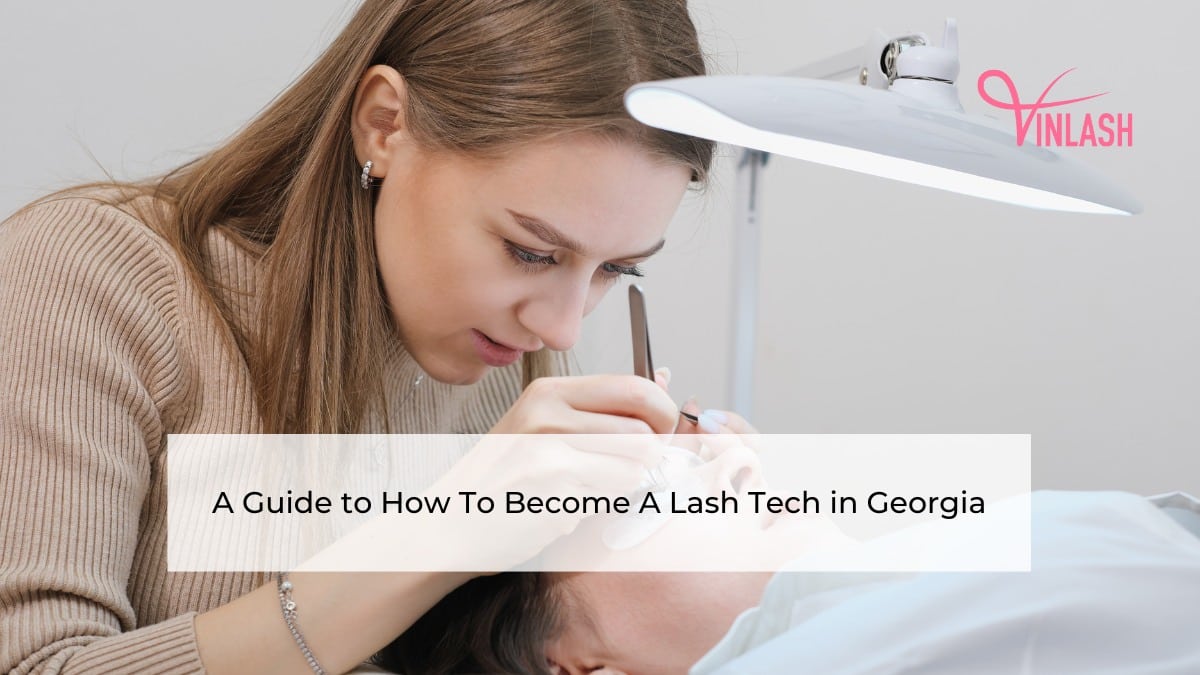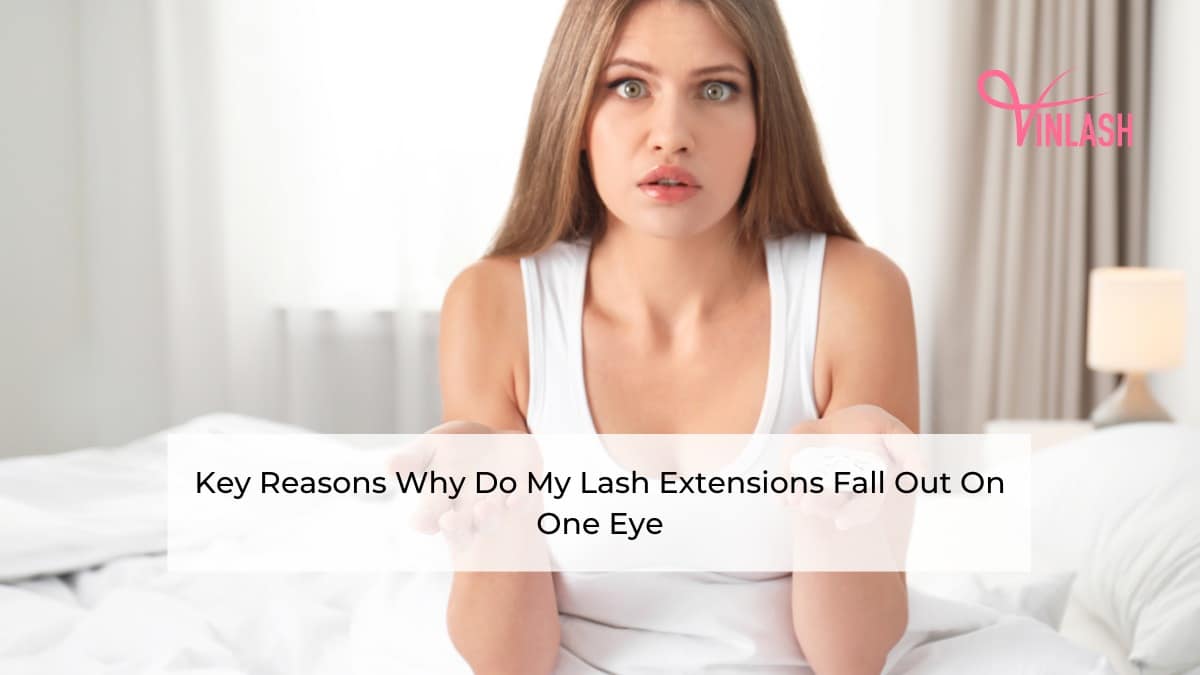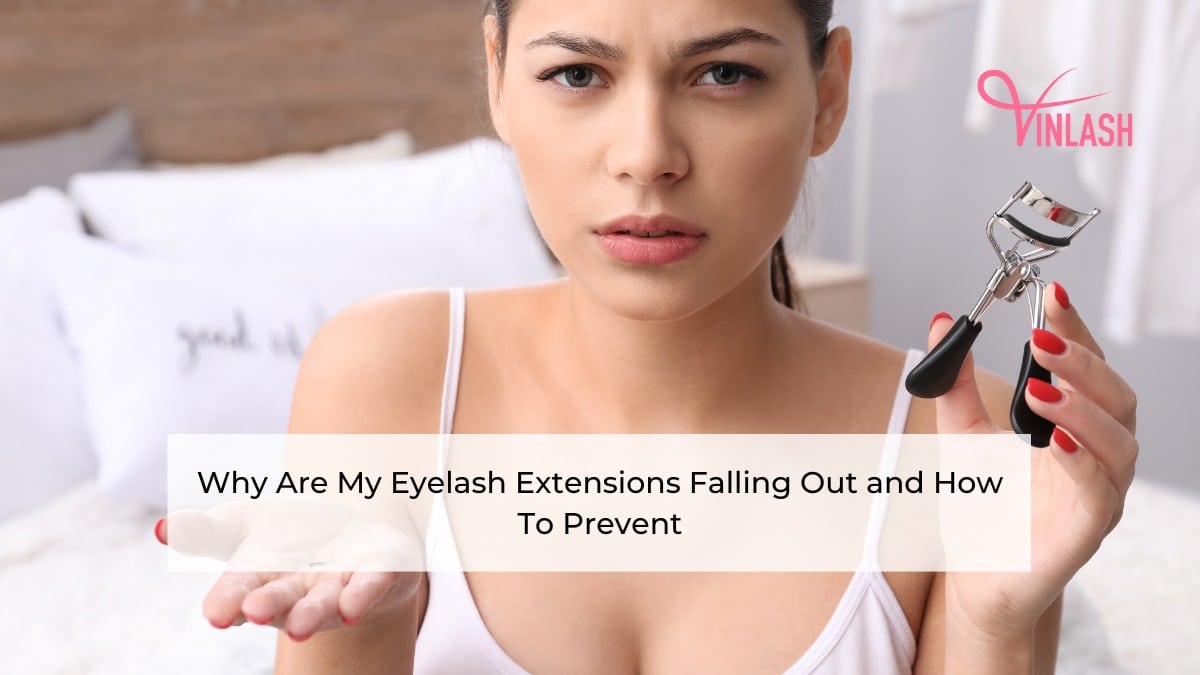Discover essential tips for managing and preventing blepharitis eyelash extensions. Ensure eye health and beauty with our comprehensive care guide.
Blepharitis, a common yet often overlooked condition, can emerge as a significant concern following eyelash extension procedures. This condition, marked by eyelid inflammation, can lead to discomfort, redness, and irritation, affecting those who seek the aesthetic enhancement of lash extensions.
The intersection of beauty and health is critical here, as blepharitis directly links to the practices and materials used in eyelash extensions. This article aims to shed light on this connection, offering insights and practical guidance on navigating the complexities of blepharitis eyelash extensions.
Contents
Understanding Blepharitis in the Context of Eyelash Extensions
In this section, we delve into the specifics of blepharitis, particularly how it relates to eyelash extensions. We will explore the definition and different types of blepharitis, causes, and symptoms, offering a comprehensive understanding of this condition in the context of eyelash enhancements.
What Is Blepharitis Eyelash Extensions?
Blepharitis refers to inflammation of the eyelids. To understand this condition in the context of lash extensions better, let’s look at some key aspects:
- The condition of blepharitis can arise post eyelash extension application, stemming from factors like hygiene lapses or material sensitivities.
- There are two main types of blepharitis eyelash extensions: Anterior and posterior blepharitis. Specifically, anterior blepharitis affects the outer part of the eyelids and lash line, often caused by bacteria buildup or mites. Posterior blepharitis impacts the inner edge of the eyelid, resulting from clogged oil glands, often linked to skin conditions like rosacea.
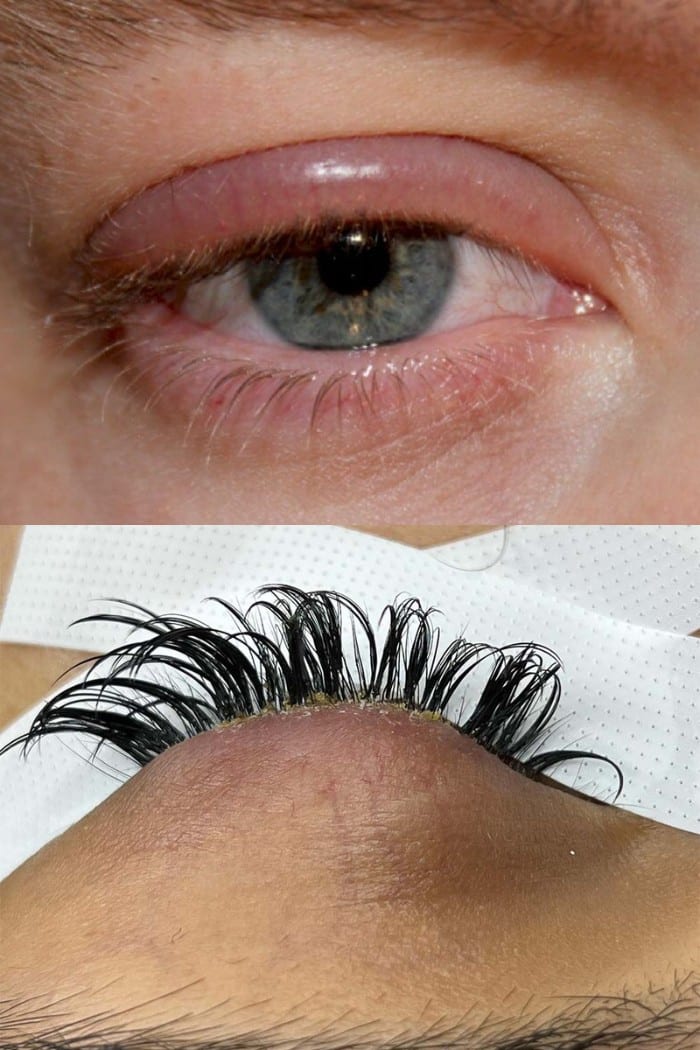
What Is Blepharitis Eyelash Extensions?
In conclusion, understanding blepharitis in the realm of eyelash extensions is crucial for preventing and managing this condition effectively.
Causes of Blepharitis in Eyelash Extension Wearers
Why does blepharitis occur following eyelash extension procedures? This section focuses on exploring the common causes behind this condition, enhancing awareness and prevention strategies.
- Bacteria Buildup Due to Improper Hygiene During Extension Application: When eyelash extensions are applied in an unsanitary environment, or with unsterilized tools, there’s a significant risk of bacteria being introduced to the sensitive eye area. This bacterial buildup can easily infect the eyelid margins, leading to an inflammatory response known as blepharitis. The risk is heightened if the technician’s hands are not properly sanitized or if the client’s eyelids aren’t adequately cleaned before the application.
- Too Many Eyelash Mites Due to Not Cleaning Eyes Well: Eyelash mites, though naturally occurring, can proliferate excessively due to poor hygiene. They feed on the oils and dead skin cells on the eyelids, and an overpopulation of these mites can lead to irritation and inflammation, exacerbating the symptoms of blepharitis. Regular cleaning of the eyelids and lashes is crucial to keep these mites in check, particularly for individuals with eyelash extensions.
- Irritation or Blockage of Oil Glands Due to Improper Application Techniques: Eyelash extensions need to be applied with precision. If glue or extensions block the meibomian glands (oil glands in the eyelids), it can lead to a dysfunction of these glands. This blockage results in decreased oil secretion onto the eye surface, contributing to eyelid irritation and inflammation – key characteristics of blepharitis eyelash extensions.
- Allergic Reaction to Lash Extensions Glue Emitting High Fumes: Some lash glues release high levels of fumes that can cause allergic reaction to lash extensions in sensitive individuals. This reaction can manifest as redness, itching, and swelling of the eyelids – symptoms that closely mimic blepharitis. Choosing a low-fume glue and conducting a patch test before the application can help minimize the risk of such allergic reactions.
To conclude, understanding these causes is paramount in preventing and addressing blepharitis effectively in the context of eyelash extensions.
Common Blepharitis Eyelash Extensions Symptoms
Identifying the symptoms of blepharitis, especially when related to eyelash extensions, is essential for timely and effective management. This section highlights the typical signs that your clients might get if they have blepharitis.
- Watery Eyes: Excessive tearing, often a reflex response to irritation.
- Dry Eyes: A feeling of dryness or a lack of adequate lubrication in the eyes.
- Red Eyes: Visible redness in the eyes, indicating irritation or inflammation.
- Gritty/Stinging Sensation: A feeling as if something is in the eye, causing discomfort.
- Itchy/Red/Swollen Eyelids: The eyelids may become itchy, visibly red, and swollen.
- Sticky/Crusted Lashes: Eyelashes may stick together or develop a crust, especially after sleeping.
- Light Sensitivity: Blepharitis eyelash extensions can cause an increased sensitivity in clients’ eyes to light, leading to discomfort in bright environments.
It’s essential to educate your clients about the early symptoms of blepharitis associated with eyelash extensions. By ensuring your clients are well-informed about these symptoms, you not only help safeguard their eye health but also maintain the quality and longevity of their eyelash extensions.
How To Treat Blepharitis From Eyelash Extensions?
Addressing blepharitis effectively is crucial, especially when it occurs in the context of eyelash extensions. Vinlash outlines a step-by-step approach for treating blepharitis with eyelash extensions, ensuring that both the health of the eyes and the condition of the eyelashes are optimally managed.
- Immediate Steps: Your immediate response should be the careful removal of your client’s eyelash extensions. Your skilled approach is crucial in this delicate process to prevent any additional irritation or harm to their eyelids. Ensure that the removal is done professionally and gently, prioritizing your client’s comfort and eye health.
- Consulting an Optometrist or Ophthalmologist for Diagnosis and Treatment: If you suspect a client has blepharitis eyelash extensions, advise them to consult an optometrist or ophthalmologist. These healthcare professionals can accurately diagnose the condition and may prescribe treatments such as antibiotic ointments or eye drops.
- Guidance on Post-Removal Care: After lash extension removal, educate your clients on the importance of maintaining eyelid hygiene. Recommend gentle, fragrance-free, hypoallergenic cleansers for their lashes and eyelids to minimize further irritation.
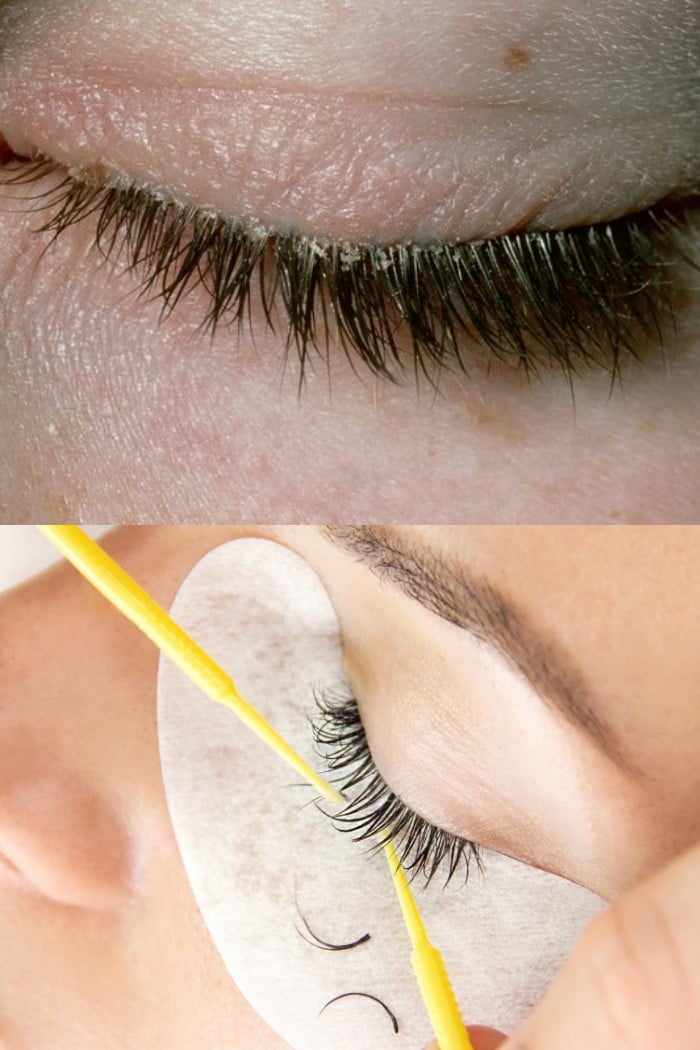
How To Treat Blepharitis From Eyelash Extensions?
Effectively treating blepharitis involves a mix of skilled intervention and providing clients with the right aftercare advice. By adopting these measures, you can help clients not only alleviate the symptoms of blepharitis but also prevent its recurrence, thereby safeguarding the health and appearance of their eyelashes.
How To Prevent Blepharitis With Eyelash Extensions?
Preventing blepharitis in clients with eyelash extensions is paramount. This section focuses on strategies to minimize the risk of blepharitis, ensuring the safety and comfort of clients while maintaining the quality of the extensions.
- Maintain High Standards of Cleanliness: It’s vital to sterilize all tools and ensure your hands are thoroughly clean before the process of lash application. This practice is key to preventing bacteria from accumulating on your client’s eyelids, which can lead to blepharitis.
- Client Education on Lash Care: Emphasize the importance of daily cleaning and maintenance of lash extensions for your clients. This step is crucial to ward off bacterial infections and lash mite infestations that can contribute to blepharitis eyelash extensions.
- Use Expert Techniques for Application: Emphasize the need for professional application of lash extensions. Skilled techniques are essential to avoid blocking the oil glands in the eyelids, which can lead to irritation and inflammation.
- Opt for Low-Fume Glues and Perform Patch Tests: Choose lash glues that emit fewer fumes and always conduct a patch test before applying them. This approach helps minimize the risk of your clients developing allergic reactions that can mimic or exacerbate blepharitis symptoms.
By adhering to these preventive measures, you can significantly reduce the risk of blepharitis for your clients. It’s not only about enhancing beauty but also about promoting ocular health and ensuring a comfortable experience for those wearing eyelash extensions.
>> See more:
- Handling Shock Polymerization Lashes Like a Pro
- How To Treat and Prevent Chemical Burn Eyelash Extensions
- A Guide To Deal With Lash Mites Eyelash Extensions
Conclusion
In summary, blepharitis is a notable concern in the realm of eyelash extensions, manifesting through symptoms like redness, itchiness, and discomfort. Prompt professional removal and medical consultation are vital for treating blepharitis eyelash extensions effectively. It’s essential to prioritize eye health alongside aesthetic enhancements.
Remember, a well-informed approach and diligent aftercare can significantly mitigate the risks associated with eyelash extensions. Stay informed, stay vigilant, and keep those lashes healthy and beautiful!
